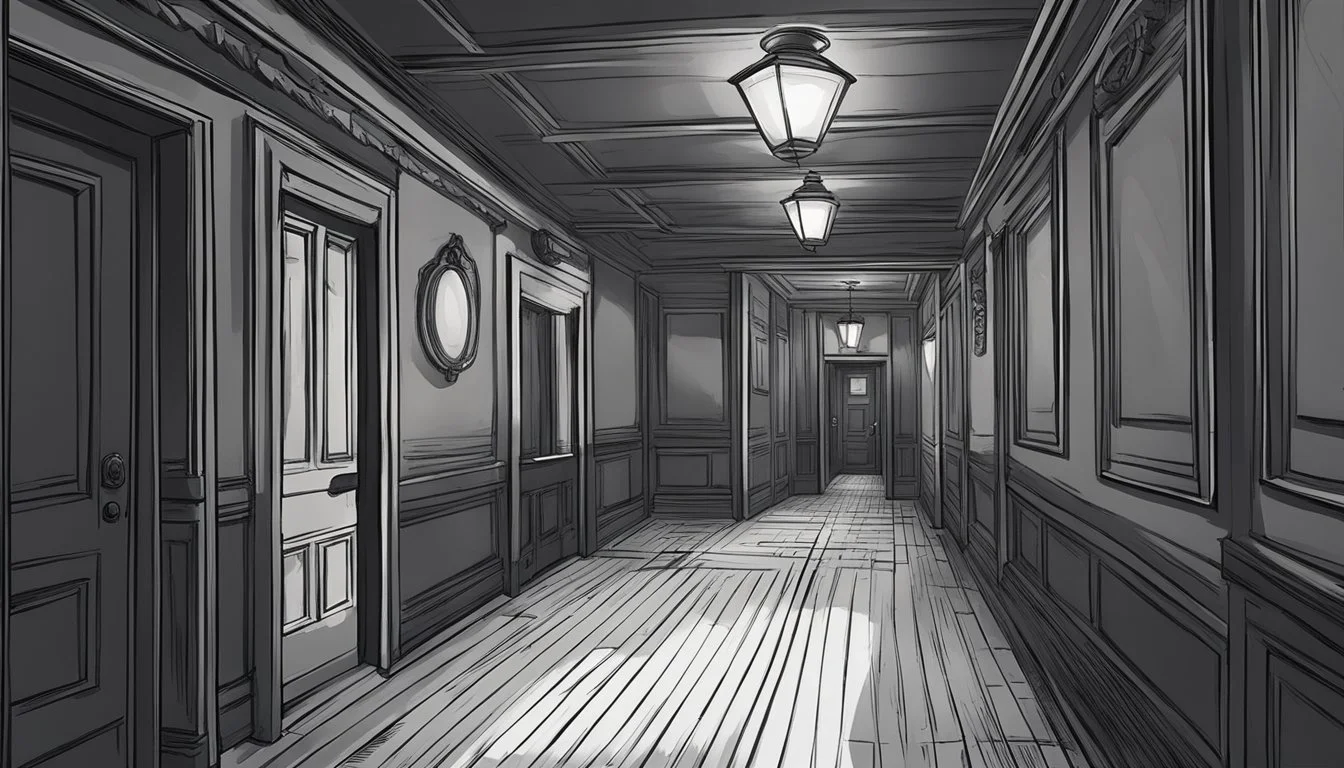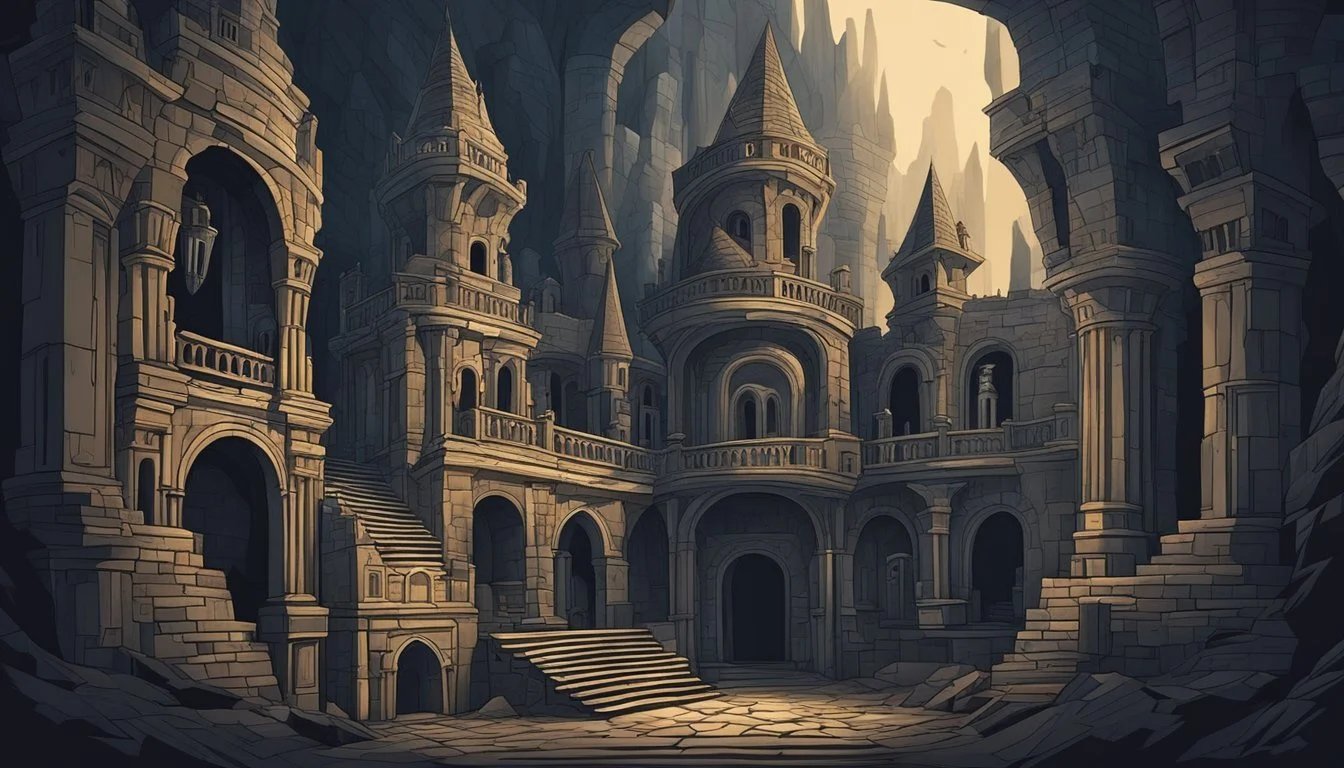H.H. Holmes: 9 Ingenious (and Terrifying) Features of America's First Serial Killer's Murder Castle
Unveiling the Horrific Design
H.H. Holmes, born Herman Webster Mudgett, gained notoriety as one of America's earliest known serial killers. During the 1893 Chicago World's Fair, Holmes operated a building that would later become infamous as the "Murder Castle." This elaborate structure contained hidden rooms, secret passages, and sinister devices designed for nefarious purposes.
Holmes' Murder Castle incorporated numerous ingenious yet terrifying features that aided him in committing his heinous crimes. The building's layout and custom modifications allowed Holmes to carry out murders and dispose of bodies while evading detection. From gas lines to soundproof rooms, each element of the castle played a role in Holmes' deadly schemes.
1) Secret Passageways
H.H. Holmes' Murder Castle was riddled with hidden corridors and secret passageways. These covert routes allowed Holmes to move undetected throughout the building, giving him easy access to unsuspecting victims.
The labyrinthine network of passages connected various rooms and floors. Some were concealed behind false walls or hidden doors, while others were accessed through trapdoors in the floors.
Holmes used these passageways to spy on guests and employees. He could enter rooms silently, catching occupants off guard. The secret routes also provided quick escape options if needed.
Many of the hidden corridors led to Holmes' private quarters and workshop. This allowed him to transport bodies and evidence without being seen by other residents or visitors to the building.
The complex maze-like design of the passageways made it difficult for victims to escape. Those unfamiliar with the layout could easily become disoriented and trapped within the walls of the Murder Castle.
2) Hidden Trapdoors
H.H. Holmes' Murder Castle was infamous for its numerous hidden trapdoors. These concealed openings in floors and ceilings played a crucial role in Holmes' sinister schemes.
Trapdoors were strategically placed throughout the building, allowing Holmes to move unseen between levels. Some were designed to open suddenly, dropping unsuspecting victims into rooms below.
Many of these trapdoors were cleverly disguised, blending seamlessly with the surrounding floor or ceiling. This made them nearly impossible for guests to detect, adding to the castle's labyrinthine nature.
Holmes often used these trapdoors to surprise and disorient his victims. They provided quick escape routes for him and convenient ways to dispose of bodies.
The exact number of trapdoors in the Murder Castle remains unknown. However, investigators discovered dozens during their exploration of the building after Holmes' arrest.
These hidden passages contributed significantly to the castle's reputation as a house of horrors. They exemplify Holmes' meticulous planning and the lengths he went to in order to carry out his crimes undetected.
3) Asphyxiation Chambers
H.H. Holmes constructed specialized chambers within his Murder Castle designed for asphyxiating victims. These rooms were equipped with gas pipes connected to a control panel in Holmes' office.
At his discretion, Holmes could release lethal gas into the sealed chambers, suffocating any unfortunate occupants. The gas used was likely a mixture of carbon monoxide and other toxic fumes.
The chambers were soundproofed and airtight, preventing escape or cries for help. Some reports suggest Holmes observed his victims through peepholes as they succumbed to the poisonous atmosphere.
After death, bodies could be easily disposed of via chutes leading to the basement. There, Holmes had acid vats and a crematorium to destroy evidence.
The exact number of victims killed in these chambers remains unknown. Holmes confessed to 27 murders, but some estimates place his total much higher.
4) Soundproof Rooms
H.H. Holmes incorporated soundproof rooms into his notorious Murder Castle. These specially designed chambers were constructed with thick walls and insulated materials to prevent noise from escaping.
The purpose of these soundproof rooms was sinister. They allowed Holmes to carry out his gruesome acts without alerting other guests or passersby to the screams and pleas of his victims.
These rooms were strategically placed throughout the building, often connected to secret passages and trapdoors. This layout gave Holmes the ability to move between rooms undetected and isolate his victims.
The soundproofing materials used likely included multiple layers of brick, wood, and other dense substances. Some accounts suggest Holmes may have used asbestos or similar fire-resistant materials for additional insulation.
These carefully engineered spaces demonstrated Holmes' meticulous planning and architectural knowledge. They played a crucial role in concealing his crimes and maintaining the illusion of a normal hotel operation.
The soundproof rooms stand as a chilling testament to Holmes' calculated approach to murder. They highlight the premeditated nature of his crimes and his efforts to avoid detection.
5) Quicklime Pits
H.H. Holmes incorporated quicklime pits into his Murder Castle as a grisly disposal method for his victims' remains. These pits were strategically located in the basement of the building, away from prying eyes.
Quicklime, also known as calcium oxide, is a highly caustic substance that rapidly decomposes organic matter. When combined with water, it generates intense heat and accelerates the breakdown of bodies.
Holmes utilized these properties to his advantage, depositing corpses into the pits to destroy evidence of his crimes. The caustic nature of quicklime helped dissolve flesh and bones, making identification of victims nearly impossible.
The use of quicklime pits demonstrated Holmes' meticulous planning and knowledge of chemistry. It allowed him to maintain a clean and odor-free environment within the Murder Castle, despite the heinous acts committed there.
This disposal method also enabled Holmes to continue his killing spree undetected for an extended period. The quicklime pits were just one of many sinister features that made his Murder Castle a true house of horrors.
6) Suffocation Beds
H.H. Holmes' Murder Castle contained sinister innovations designed to facilitate his gruesome crimes. Among these were the notorious suffocation beds, which allowed Holmes to silently eliminate his victims.
These beds were equipped with airtight chambers that could be sealed from the outside. Once a victim was asleep, Holmes would activate the mechanism, trapping them inside and cutting off their oxygen supply.
The beds were often placed in soundproofed rooms to muffle any cries for help. This allowed Holmes to carry out his murderous acts without arousing suspicion from other guests or passersby.
Some accounts suggest the beds could be heated, hastening the victim's demise. Holmes reportedly used these devices to kill multiple people, though the exact number remains unknown.
The suffocation beds exemplify the calculated nature of Holmes' crimes. They demonstrate his meticulous planning and willingness to invest time and resources into creating specialized tools for murder.
7) Disguised Chutes
H.H. Holmes incorporated disguised chutes throughout his Murder Castle. These seemingly innocent architectural features served a sinister purpose in his elaborate scheme of death.
The chutes were strategically placed and often hidden from plain sight. They connected upper floors to the basement, allowing Holmes to easily dispose of bodies and evidence.
Some chutes were greased to facilitate the swift and silent descent of corpses. This design element enabled Holmes to quickly remove bodies from crime scenes, minimizing the risk of discovery.
The basement, where the chutes terminated, housed acid vats and other means of destroying evidence. This efficient system allowed Holmes to commit murders and erase traces of his victims with chilling effectiveness.
The disguised chutes exemplified Holmes' meticulous planning and engineering skills. He designed these features to blend seamlessly with the building's architecture, avoiding suspicion from unsuspecting guests or authorities.
8) Hidden Stairs
H.H. Holmes' Murder Castle contained numerous hidden staircases designed to disorient and trap victims. These concealed passages allowed Holmes to move secretly throughout the building, evading detection and surprising unsuspecting guests.
Some staircases led to nowhere, ending abruptly at blank walls or dropping into pits. Others connected to secret rooms where Holmes could observe or ambush his prey. The hidden nature of these stairs made it difficult for victims to escape once they realized they were in danger.
Holmes often used these hidden stairs to access soundproofed chambers where he conducted his gruesome activities. The intricate network of concealed passages gave him complete control over the movements of those inside his deadly maze.
By incorporating hidden stairs into his architectural design, Holmes created an environment of confusion and fear. Guests would find themselves lost and disoriented, unable to find their way out of the labyrinthine structure.
9) Airless Vaults
H.H. Holmes incorporated airless vaults into his Murder Castle design as a sinister method of torture and execution. These sealed chambers were constructed to be completely airtight, with no ventilation or oxygen supply.
Holmes would trap unsuspecting victims inside these vaults, leaving them to slowly suffocate. The lack of air created a terrifying and painful death for those unfortunate enough to be imprisoned within.
The vaults were typically hidden behind false walls or concealed within the labyrinthine layout of the building. This made it nearly impossible for victims to escape or be discovered by others.
Some reports suggest Holmes sometimes observed his victims through peepholes as they struggled for air. The airless vaults demonstrated Holmes' calculated approach to murder and his desire to inflict maximum suffering.
These chambers were just one of many lethal features in the Murder Castle. They highlight Holmes' engineering skills and the extent of his murderous planning in creating his house of horrors.
Historical Context
The late 19th century saw rapid urbanization and technological advancements in America. This period set the stage for both grand spectacles like the Chicago World's Fair and the emergence of notorious criminals like H.H. Holmes.
Chicago World's Fair and Its Influence
The 1893 World's Columbian Exposition, commonly known as the Chicago World's Fair, drew millions of visitors to the city. This massive event showcased technological marvels and architectural wonders, transforming Chicago's landscape.
The fair created a bustling atmosphere of excitement and opportunity. Visitors from around the world flocked to see exhibitions on electricity, new inventions, and cultural displays.
This influx of people provided the perfect cover for H.H. Holmes to carry out his heinous crimes. The crowded city streets and constant flow of newcomers made it easier for individuals to disappear unnoticed.
The Rise of H.H. Holmes
Born Herman Webster Mudgett in 1861, H.H. Holmes moved to Chicago in the late 1880s. He adopted the alias "Dr. Henry Howard Holmes" and began his criminal activities.
Holmes purchased a lot in Englewood, a Chicago suburb, where he built his infamous "Murder Castle." This three-story building contained hidden rooms, trap doors, and secret passages.
As Chicago prepared for the World's Fair, Holmes saw an opportunity. He advertised his property as a hotel for fair visitors, luring unsuspecting guests into his deadly maze.
Holmes' charm and confidence allowed him to manipulate those around him. He engaged in various fraudulent schemes, from insurance scams to selling stolen goods.
Structural Layout
H.H. Holmes' infamous Murder Castle was a labyrinth of deception and danger. Its intricate design concealed sinister secrets, with hidden passages and compartments carefully crafted to facilitate Holmes' murderous activities.
Design and Architecture
The Murder Castle stood three stories tall, occupying an entire city block in Chicago's Englewood neighborhood. Its exterior appeared unremarkable, blending in with surrounding buildings. The ground floor housed legitimate businesses, including a pharmacy and jewelry store run by Holmes.
Upper floors contained a maze-like network of over 100 windowless rooms, doorways opening to brick walls, and staircases leading nowhere. Some rooms were soundproofed and equipped with gas lines, allowing Holmes to asphyxiate victims.
Hidden chutes enabled body disposal to the basement. Holmes installed a kiln and acid vats there for destroying evidence. The building's complex layout disoriented victims and concealed Holmes' crimes from authorities.
Secret Passages and Hidden Compartments
Holmes incorporated numerous concealed spaces throughout the Murder Castle. False walls and sliding panels provided access to secret rooms and escape routes. Trapdoors in hallway floors led to chutes for quickly moving bodies.
Some guest rooms featured hidden peepholes and alarm systems, alerting Holmes to occupants' movements. Closets and wardrobes often disguised entrances to cramped, coffin-like spaces where victims were trapped.
The basement held the most sinister secrets. A hidden dissection room allowed Holmes to harvest organs and skeletons for sale to medical schools. Soundproof vault rooms served as gas chambers. These covert areas played a crucial role in Holmes' ability to carry out his gruesome acts undetected.




